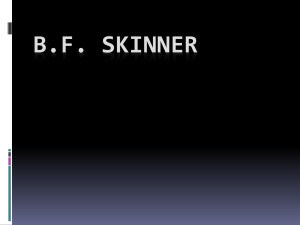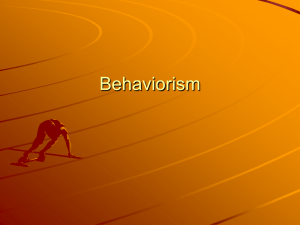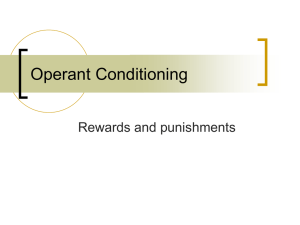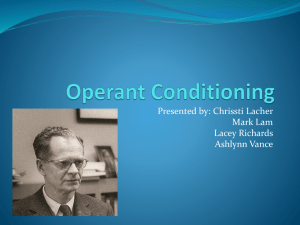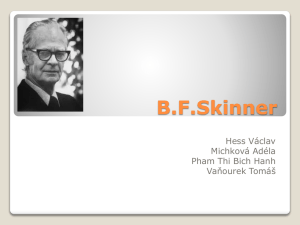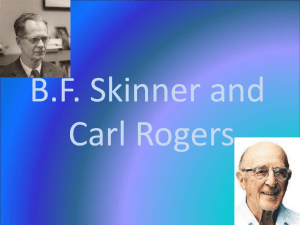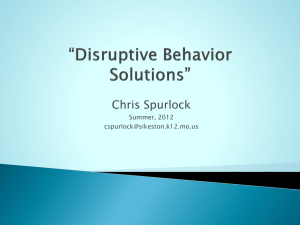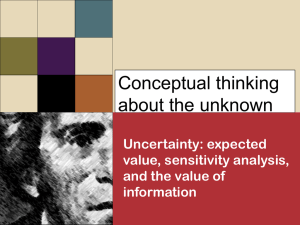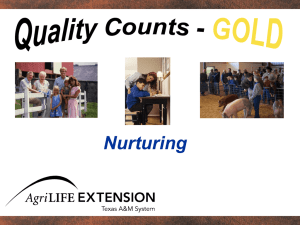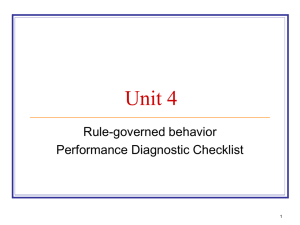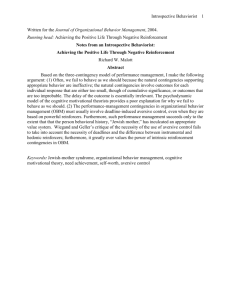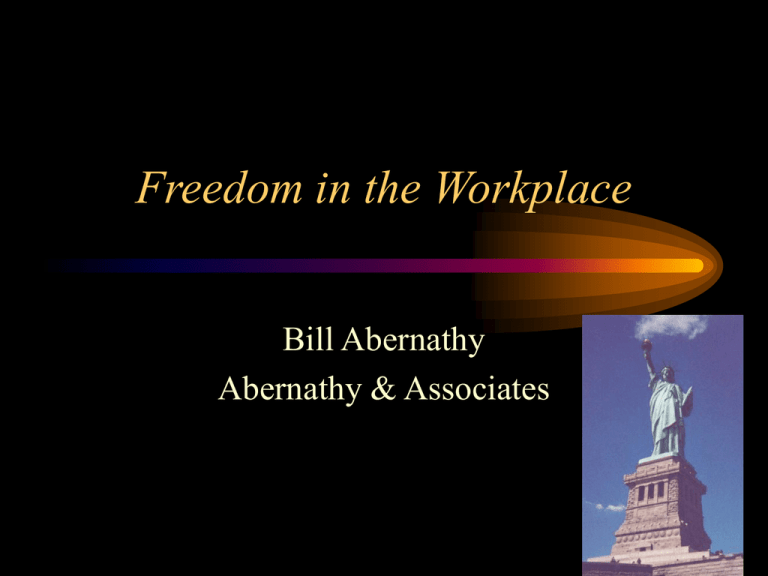
Freedom in the Workplace
Bill Abernathy
Abernathy & Associates
Individual Freedom and OBM
• What is OBM’s mission?
– Scientific study of human behavior in
organizational settings?
– Improve performance management?
– Improve employee performance?
– Improve organizational profitability?
• To increase personal freedom in the workplace?
Key Presentation Concepts
•
•
•
•
•
•
•
Freedom
Negative Reinforcement
Hierarchy of Needs
Natural Selection
Open Systems
Self-Actualization
Contingency-Shaped Behavior
What is freedom?
“A perfect balance between the right of an individual to act
without undue interference and the need of the community
to restrain freedom of action has often been projected in
theory but has never been achieved. The restraints
imposed throughout most of history have been oppressive.”
(Encarta)
John Locke
"The end of the law is not to abolish or restrain but to
preserve and enlarge freedom. For in all the states of created
beings capable of laws, where there is no law, there is no
freedom. For liberty is to be free from restraint and violence
from others; which cannot be where there is no law."
George Washington
"Government, like fire, is a dangerous servant and a fearful
master. "
Thomas Jefferson
"The course of history shows that as a government grows,
liberty decreases."
Lord Acton
"Power tends to corrupt, and absolute power corrupts
absolutely.”
C. S. Lewis
"Subjectivism about values is eternally incompatible with
democracy. We and our rulers are of one kind only so
long as we are subject to one law."
John F. Kennedy
"We are not afraid to entrust the American people with
unpleasant facts, foreign ideas, alien philosophies, and
competitive values. For a nation that is afraid to let its
people judge the truth and falsehood in an open market is
a nation that is afraid of its people."
free·dom noun
ability to act freely: a state in which somebody is able to act and live as he or
she chooses, without being subject to any, or to any undue, restraints and
restrictions - live in freedom
release from captivity or slavery: release or rescue from being physically
bound, or from being confined, enslaved, captured, or imprisoned - hostages
enjoying their first taste of freedom for months
right to act or speak freely: the right to speak or act without restriction,
interference, or fear - were given the freedom to take photographs and interview
workers
absence of something unpleasant: the state of being unaffected by, or not
subject to, something unpleasant or unwanted - Freedom from want or fear is one
of society's four principal freedoms.
B. F. SKINNER FOUNDATION
B. F. SKINNER FOUNDATION
A Brief Survey of Operant Behavior
B.F. Skinner
“Historically, people have been controlled primarily through
negative reinforcement that is, they have been punished
when they have not done what is reinforcing to those who
could punish them. Positive reinforcement has been less
often used, partly because its effect is slightly deferred, but it
can be as effective as negative reinforcement and has many
fewer unwanted byproducts.
B. F. SKINNER FOUNDATION
A Brief Survey of Operant Behavior
B.F. Skinner
“Personal freedom also seems threatened. It is only the
feeling of freedom, however, which is affected. Those who
respond because their behavior has had positively
reinforcing consequences usually feel free. They seem to be
doing what they want to do. Those who respond because the
reinforcement has been negative and who are therefore
avoiding or escaping from punishment are doing what they
have to do and do not feel free. These distinctions do not
involve the fact of freedom.”
Two Approaches to Management:
Positive vs. Negative Reinforcement
+ Reinforcement
- Reinforcement
food
shock
Maslow’s Hierarchy
Maslow’s Hierarchy of Needs
1. Physiological (hunger, thirst, shelter, sex, etc.)
2. Safety (security, protection from physical and emotional
harm)
3. Social (affection, belonging, acceptance, friendship)
4. Esteem (The internal ones are self-respect, autonomy, and
achievement and the external ones are status, recognition,
and attention.)
5. Self actualization (realizing personal potential)
An Effective Behavior System
Need
• Physiological
• Safety
• Social
• Self-Esteem
• Self-Actualization
System component
• Pay
• Job security
• Mutual contingencies
• Minimum aversive control,
feedback, recognition
• Self-managed, unrestrained
opportunity
All participants must share fairly
in the organization’s success.
Owners
Customers
PROFITS
Employees
1. PAY
Profit Sharing
• Owners must receive a good return on their
risk and investment.
• Employee pay should be unlimited through
indexing pay to organizational profit.
• Customers must share in performance
improvement through lower prices, better
service, and product innovation.
1. PAY
“Commodity” pay is converted
to performance pay.
• Commodity pay is
determined by education
and experience.
• Performance pay is
determined by
organizational and
personal performance.
1. PAY
Effects of Profit-indexed Pay
PROFIT
EMPLOYEE
PAY
1. PAY
Vertical career paths are replaced
with lateral career paths.
• The practice of
rewarding high
performers with
promotions is
eliminated.
• Lateral-career paths
achieved through open
book management, job
enrichment and job
enlargement.
1. PAY
Effects of Fixed Cost Wages and Salaries
Employees do not
share in success.
Employees
risk losing
jobs during
downturns.
2. JOB SECURITY
Transition from reliance on aversive
control to positive reinforcement.
• Aversive control
– reduces job security
– requires ambiguity and uncertainty
– creates conflict between management and labor
• Positive Reinforcement
– increases job security
– requires clarity and certainty
– fosters cooperation between management and
labor
2. SECURITY
Balance individual and
group contingencies.
• Profit sharing is a “meta”
group contingency.
• Small team performance
measures reinforce
cooperation.
• Personal performance
measures ensure equity
and provide for esteem
and self-actualization
needs.
3. SOCIAL
Balance individual and
group contingencies.
• Eliminating promotions as
rewards reduces
competition.
• Transition of managers
from aversive supervision
to positive facilitation
improves cooperation.
3. SOCIAL
Without a score, there is no game.
• A sense of personal
achievement requires
an objective and
feedback on progress.
• Personal achievements
that benefit the group
result in recognition
and status from the
group.
4. ESTEEM
Abraham Maslow
"A musician must make music, an artist must paint, a poet
must write, if he is to be ultimately at peace with himself. What
a man can be, he must be."
5. Self-actualization
Nelson Mandela
Our deepest fear is not that we are inadequate.
Our deepest fear is that we are powerful beyond measure.
5. Self-actualization
B.F. Skinner
Contingencies of Reinforcement: A Theoretical Analysis
• (3) Culture-bound vs. “natural behavior”.
Rules evolve with the culture and differ
among cultures; behavior shaped by
nonsocial contingencies is as universal as
the contingencies.
• (6) Intellect vs. Emotion. Rule-governed
behavior may be cold and Stoical;
contingency-shaped behavior is likely to be
5. Self-actualization
hot and Epicurean.
B.F. Skinner
Contingencies of Reinforcement: A Theoretical Analysis
• (8) Anxiety vs. joy. The ethical, legal and
other sanctions which enforce rules are
usually aversive and the emotional
responses associated with rule-governed
behavior (“anxiety”} are then evoked by
preaversive stimuli. The strong positive
reinforcers which shape behavior directly
are more likely to be associated with “joy.”
5. SELF-ACTUALIZATION
B.F. Skinner
Contingencies of Reinforcement: A Theoretical Analysis
• (9) Monotony vs. variety. Rule-governed
behavior is usually designed to satisfy
contingencies, not to duplicate other
features of the behavior shaped by them.
Contingency-shaped behavior is therefore
likely to have a greater variety or richness.
5. SELF-ACTUALIZATION
B.F. Skinner
Contingencies of Reinforcement: A Theoretical Analysis
• (12) Formula vs. art. As Francis Bacon
said, a painter or musician excels “by a kind
of felicity and not be rule,” where felicity
seems to refer to the happy consequences
which guide the artist in lieu of rules in the
production of art.
• (16) ... Contingencies contain reasons which
rules can never specify.
5. SELF-ACTUALIZATION
Advantages of a “self-actualizing”
employee group
•
•
•
•
•
•
Execute new strategies rapidly
Continuous personal improvement
Expanded initiative and innovation
Require little or no direct supervision
Long-term commitment to the organization
Competition superceded with cooperation
Conditions
for self-actualization
CAPABILITY
OPPORTUNITY
Work Input
TARGET MEASURE
Time
Input
Quality
Assignments
Proactive
Input
Work
Schedule
Over
Staffing
Work
Competence
Off-task
Distribution
Attendance
Selection
Training
CONTEXT
Resources
Processes
Supplies
Job
Methods
Tools
Work
Flow
Under
Staffing
Prompts
Feedback
Reinforce
Instructions
Immediate
Positive
Job Aids
Frequent
Immediate
Personal
Certain
Actionable
Aligned
Common Concepts?
•
•
•
•
•
Natural Selection
Free Enterprise
Free Operant
Open System
Self-Actualization
Charles Darwin,
The Origin of Species 1859
• In the struggle for survival, the fittest win
out at the expense of their rivals because
they succeed in adapting themselves best to
their environment.
Adam Smith, 1776, "An Inquiry into the
Nature and Causes of the Wealth of Nations"
– Every individual necessarily labours to render the
annual revenue of the society as great as he can.
He generally neither intends to promote the public
interest, nor knows how much he is promoting it.
He intends only his own gain, and he is in this, as
in many other cases, led by an invisible hand to
promote an end which was no part of his intention.
B.F. Skinner, A Brief Survey of Operant
Behavior
• The innate behavior studied by ethologists is
shaped and maintained by its contribution to the
survival of the individual and species. Operant
behavior is shaped and maintained by its
consequences for the individual. Both processes
have controversial features. Neither one seems to
have any place for a prior plan or purposes. In
both, selection replaces creation.
Von Bertalanffy
– OPEN SYSTEM
• A system with input, an entity that changes its
behavior in response to conditions outside its
boundaries. Systems are rarely ever either open
or closed but open to some and closed to other
influences. Adaptation, learning and all
manifestations of intelligence require some
openness to information.
Employees in conventional
organizations work in closed systems.
Closed System
• Executive Directives
• Management Hierarchy
• Departmental “Silos”
• Direct Supervision
• Wages and Salaries
• Aversive Control
Open System
• Open Book Management
• Flat Organization
• Shared Contingencies
• Self-Managed
• Profit Sharing
• Positive Reinforcement
Advantages of an Open System
•
•
•
•
•
•
Responsive to external events
Nimble, ability to change rapidly
Continuous improvement
Customer focus
Profit focus
Resilient and sustainable
Research Agenda
Techniques for:
– employee buy-in to measurement and stakeholder
pay
– employee shift to variable schedules where results
are not completely predictable or controllable
– reinforcement shift from short-term to long-term
– ensuring consistent and sustained effective
management practices
Research Agenda
Techniques for:
– creating contingencies that connect innovation
and initiative to reinforcers
– developing lateral career paths
– increasing management span of control
– ensuring continuous alignment between
employee measures and goals and the
organization’s measures and goals
– statistically evaluating system constraints


